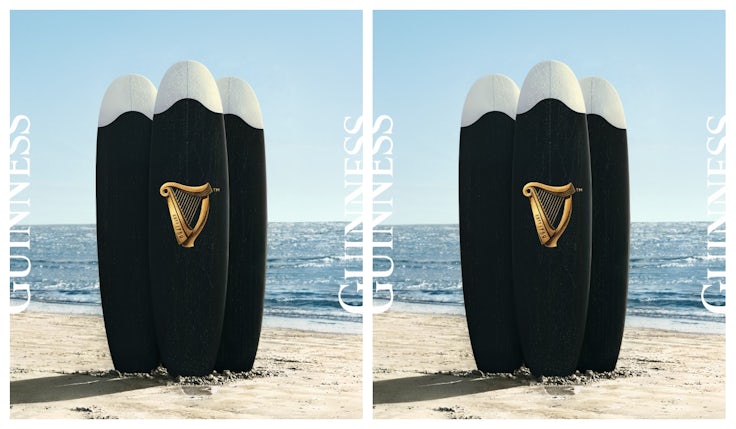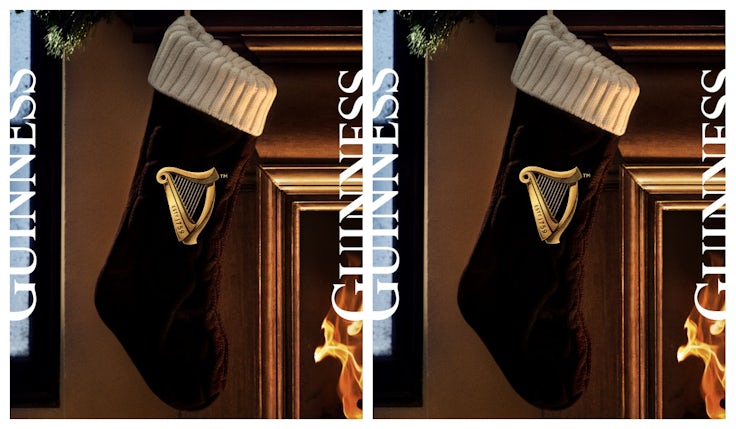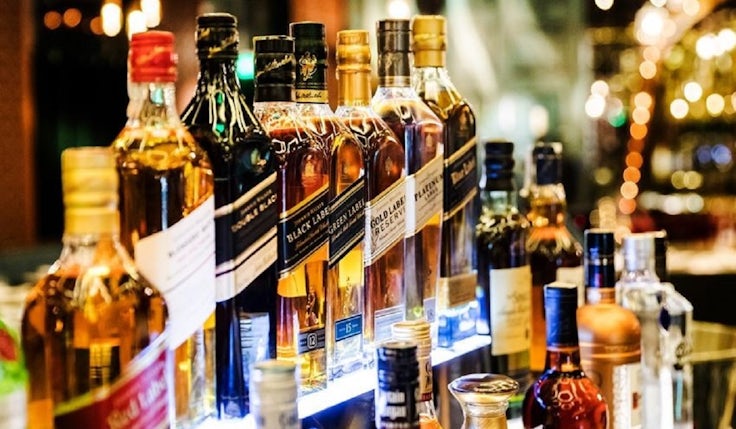How Guinness became Britain’s most popular pint
Guinness is the rare example of a brand with solid foundations in its product and brand assets, whose full potential is realised by brilliant marketers.
 “I never believed I’d see this day. It’s fantastic,” Diageo’s CEO Ivan Menezes told analysts during a conference call last week to discuss the company’s results. The day in question was when Guinness became the most popular pint in Britain. The Irish icon now accounts for one in every nine pints pulled in the UK. And the result is echoed across Europe, with Guinness enjoying an impressive 19% boost in sales over the preceding 12 months.
“I never believed I’d see this day. It’s fantastic,” Diageo’s CEO Ivan Menezes told analysts during a conference call last week to discuss the company’s results. The day in question was when Guinness became the most popular pint in Britain. The Irish icon now accounts for one in every nine pints pulled in the UK. And the result is echoed across Europe, with Guinness enjoying an impressive 19% boost in sales over the preceding 12 months.
Normally, when a brand that old enjoys a boost this big, it’s because of a new line extension or product innovation. But a pint of Guinness is, to all intents and purposes, the same now as it was back in 1759 when it first poured from the barrel. Prices, if anything, have gone up not down. And distribution is ostensibly the same as it was a year ago.
So how did Guinness grow so much? The answer: fundamental marketing done brilliantly. No new tech. No alternative approach. Just the textbook applied, beautifully, to an exceptional brand. Here are nine lessons from the ancient Irish wonder and its marvellous marketing team.
1. The raw material is good
The reasons below are about exceptional marketing. But before we get to them it’s important to acknowledge the inherent benefits of the product and pre-existing advantages of the Guinness brand. Too often in marketing, we forget the most important of the four Ps – product – and assume success was all about amazing brand management, ignoring the residual power of the brand in driving sales.
Brand equity and brand management are two separate, eventually correlated, inputs into sales success. Shit brand managers work on great brands and get away with it. Good brand managers work on shit brands and don’t. In the case of the Guinness GB team, we encounter an exceptional group of marketers. But it also helps when those marketing skills are applied to a brand that exhibits such immense extant appeal.
‘It only works if it all works’: Marketers on ‘reclaiming’ the 4Ps
2. It is a team effort
The story of Guinness’s growth is attributable to a smart, effective and extremely humble marketing team and not any solo marketing superstar. This was a team effort, people at Diageo repeatedly told me. How refreshing in the age of overstated marketing leadership and personal career branding to encounter genuine humility and a respect for team dynamics and agency partners. And how telling that one of the big brand success stories of recent times comes not from an insufferable egotist with a vision but from a culture of teamwork, equality and humility.
3. Social listening
Too often, marketers have written the words ‘social listening’ as a segue into some deeply dodgy dashboard that uses real-time social media interaction analysis to deliver brand metrics, line charts and other percentile stuff. That’s an error because the very nature of the social media population makes them a potent example of sample bias. I don’t know about you, but my social media activity isn’t even representative of me, never mind any broader group. Drawing quantitative lessons from social media is an unavoidably ropey affair.
But as a qualitative tool, freed from any nomological expectations, social listening represents a fantastic way to stay close, learn about and draw inspiration from the market – in real time. Social media data will never become an adequate replacement for a properly recruited survey sample. But it is a very good online equivalent to a giant global focus group that never ends and costs you nothing.
And that’s exactly how the Guinness team used it. As lockdown struck across the UK, the brand was able to use social listening to tap into two big insights – one macro and one micro – that would set up the success that followed.
First, with bars and restaurants closed, the desire for a decent pint grew exponentially with every passing week for many people locked in at home. And Guinness, which often features high up the drinking desire list when consumers have a proper thirst, was a product that lockdown consumers longed for more than most.
Second, at a more micro level, the Guinness team began to observe the manifestation of this unsatiated desire as people posted images from their pandemic lives that resembled a pint of Guinness. This tiny trend, which eventually evolved into #LooksLikeGuinness, became a crucial input into the campaign that was to follow.
4. Play the long game
During the pandemic, too many big brands, from Coca-Cola down, made the decision to pull their marketing communications because demand was either low or significantly altered by Covid. If you understand the long- and short-term value of marketing communication, this decision made very little sense.
Brands should have pulled back their short-term promotional spend if immediate demand was hit by the pandemic. But long-term brand communication should have been maintained, even during Covid, because the timeline of impact for this kind of investment is years, not months, and Covid was always going to subside eventually.
P&G and Coke’s pandemic performances prove it: You don’t cut ad spend in a crisis
Given most companies were cutting their pandemic brand budgets, there was also an extra bonus from the increased excess share of voice enjoyed by those brands savvy enough to maintain branding efforts in the face of the Covid threat. Unless you really thought lockdown was going to last for three or more years, brand investment during the pandemic made sense.
In the case of Guinness, there was still the growing potential from off-premise beer sales to support during the pandemic, as people drank cans at home rather than pints in a pub. But the team were also fully aware that advertising through and about Covid would stoke the longer-term flames of on-premise desire when pubs finally opened again.
Guinness has been adept at not just codifying its communications with KBAs, it has assiduously varied the context of its messages to also reinforce the various category entry points that Guinness aspires to own.
Even in the darkest days, the Guinness team kept their focus on “winning the first pint” when pubs reopened. The nature of long-term brand building is such that you cannot just turn it off and then back on again at a moment’s notice when demand restarts. The brands that kept their brand burning during the darkness of Covid were the ones that grew the most when the market eventually returned.
5. Integrated marketing communications
Most marketers still struggle with the idea that there is no single superior medium. But there isn’t. First, because it depends on the strategic situation of the brand (target, position, objective, budget, category). Second, because media diversity dictates that the interaction effects of multiple media combined into an integrated campaign will almost always outperform any single-medium approach. More is more with media.
The Guinness team knew this. Having developed their own in-house marketing mix modelling (MMM) system called Catalyst, they were aware of the right media to use, in which situations, in what combinations and across which sequences. Working with AMV BBDO and PhD, an integrated campaign was created from television, social, OOH and point of sale. It was built out of the insight that there was a growing desire for a pint and from a sensitive appreciation of what consumers and customers had gone through. Crucially, and unlike so much pandemic advertising, it also kept the product at the centre of it all too.
The campaign originated with the original organic social media images from consumers seeing Guinness in their everyday lockdown lives. The greatest ideas often come from the market itself rather than creative teams. That should hardly be a surprise – you have maybe 20 creative people at your disposal and 4 million customers. Run the numbers.
But that origin does not reduce the plaudits that Guinness and its agency partners now deserve. It takes marketing skill and humility to identify and adopt these market-oriented ideas. And how you scale and replay them as a broader inorganic campaign remains an enormously difficult challenge. Someone picked ‘Always on My Mind’ for the soundtrack, and it wasn’t a lonely Guinness drinker with an iPhone.
6. Use Your KBAs
KBA is the Diageo acronym for ‘key brand asset’. Whether you instead call them DBAs, codes, fluent devices or brand assets, there is no doubt that the palette of sensual identifiers are a key part of 21st-century brand building. And Guinness obviously has more strength in this department than most brands. Kantar actually ranks Guinness as the most distinctive beer on the planet and the fifth most distinctive brand overall.
But it’s one thing to manage a brand that has distinctive assets, quite another not to take them for granted or grow bored and start working with new, less effective stuff. I’ve spent my career upsetting brand managers because their work is just not distinctive enough and because it does not lean heavily enough on the KBAs of the brand. The problem is always the same: after five or 10 years working on a brand for six to eight hours a day and using the same four or five KBAs, the management team grow weary and want something new.
That’s an enormous mistake because customers don’t grow bored. Most don’t even notice the brand in the first place. Being market-oriented partly means realising that consumers don’t spend even six seconds thinking about your brand, let alone six hours. They don’t get bored of your KBAs because – unlike you – they don’t look at them for long and are exposed to a zillion competitor ones at the same time. If there is one rule I drum, drum, drum into the brand managers I train on the Mini MBA in Brand Management, it’s that you must: Codify. The. Shit. Out. Of. Everything.
Everything.

Guinness does not need that lesson. It could teach the whole class. Despite more than a quarter of a millennium with the same handful of KBAs, the team has always remained focused on them. In fact, for the last three years they have focused away from some of the KBAs of the brand like the Guinness script and the harp and instead gone overweight on the black-and-white colour code. Lockdown seemed to revitalise this KBA and the team have used it during and after lockdown, and now during the growth period that has followed.
“What is key to making Guinness so distinctive is the quarter white and three quarters black pint, which is unmistakably Guinness and our most memorable key brand asset,” Neil Shah, the head of Guinness in the UK, recently explained.
Strategy is choice and it’s never more discerning than when a marketer sets the brand objectives for the year ahead.
“This has been central to growing distinctiveness and salience on Guinness across our 264-year history, for example a pint balancing on a flying Toucan’s beak in the historic Gilroy print advertising. #LooksLikeGuinness was about building on this and contemporising how we use it, after observing how consumers organically posted images of everyday objects that looked like [the black and white] pint, showing how much they missed a pint of Guinness in the pub during lockdown.”
7. Category entry points
Guinness is lucky but it needed the marketing team in charge to make the most of that luck. The Guinness brand has a rare ability to appeal across very different drinking moments. Its temperature makes it a very attractive summer pint. Its density and darkness make it a refreshing drink in the winter. It’s a Christmas tipple that has strong festive associations.
All these and more category entry points exist, but they need marketing fuel. Fuel to ensure they stay prominent in the mind of the existing market. Fuel to ignite the associations of new generations of drinkers, and to show them how and when they should indulge.

Guinness has been adept at not just codifying its communications with KBAs, it has assiduously varied the context of its messages to also reinforce the various category entry points that Guinness aspires to own. “Using this method and focusing on key consumer occasions has helped us to continue to recruit new drinkers broadly across age demographics over the legal purchasing age, genders, and all over Great Britain, in both pubs and at home,” Shah confirmed.
It’s clear with all this talk of distinctiveness, brand assets and category entry points that Guinness is very much a brand that has followed the Ehrenberg-Bass Institute’s system of brand growth. We must tip our hat once again to the Dark Lord Byron Sharp and his team, because not only is a big brand company like Diageo applying the lessons of the Institute, it is reaping rich rewards from doing so.
But, as seems to be the norm, Guinness is a brand that employs an ‘Ehrenberg-Bass light’ approach. Yes, it follows many of the teachings from the ‘big red book’, but it also transgresses too. The lesson for brands, I believe, is that you cannot be successful in 2023 without understanding and adopting many of the precepts from How Brands Grow. But it’s not a total system and can be (clutches white pearls above a black dress) improved with the addition of many of the things the Institute rejects: MMM, brand meaning, funnels and long and short thinking.
8. Set a handful of long and short objectives
Diageo is famed for its marketing prowess, and rightly so. And one area where the team excelled was in setting clear, measurable objectives of two distinct types. Shorter commercial objectives were benchmarked and then monitored with business metrics. Longer-term brand goals like salience and brand meaning were assessed with consumer metrics.
The team set these objectives on an annual basis and then “worked backwards” to identify the tactics and investments that would need to be put in place to achieve them over the financial year. There are clear lessons here for marketers too.
First, that they must start with strategy in the form of targeting, position and objectives, and only then work back through the required tactics. Put down your spade and decide where you want to dig your hole. You may not even need the spade by the time you have made a good plan.
Second, even the biggest brand success will likely derive from only a handful of objectives – both long and short. Too many brands have too many objectives, which become – in the immortal worlds of AG Lafley, P&G’s former CEO – “dreams that will never come true”.
Strategy is choice and it’s never more discerning than when a marketer sets the brand objectives for the year ahead. Learn to focus, to embrace long and short, and to kill those objectives that aren’t worth the effort and which will detract from the mission ahead. The research on corporate strategy success suggests no more than a handful of objectives can be successfully achieved in most corporate settings each year. Follow that advice. Guinness did.
9. Learn from the year before
This last one sounds obvious but it’s rarely done. I’ve sat through enough brand plans for one lifetime and I can tell you exactly what good ones look like. They are presentable in 60 minutes. They start with last year’s objectives, whether they were achieved and what was learned. They lay out the new strategic objectives. Then the tactics that will deliver them. And they end with a budget slide.
Most brand plans rarely manage any of the above and fill in the gaps with concepts such as Maslow, PEST and a dirty old SWOT – the three harbingers of shit marketing – usually back-to-back in any bad brand deck. And that’s a shame, because when a brand plan starts with the lessons from the previous year it usually presages a strong plan for the year to come.
Diageo is a company that starts with lessons – what the company calls a “rigour of learning”. And it should again be a stark lesson for other brands that want to enjoy the kind of success that Guinness has achieved. In your planning sessions for the year ahead, be brave and smart enough to first look backwards. Spend a day on what you learned from last year and how those learnings will alter the approach you will adopt in the year to come.
There really aren’t super-smart and super-dumb marketers out there. There are marketers who just keep firing their tactical pistols into pitch-black rooms, never thinking to pause or turn on the lights. And there are marketers like the ones managing Guinness, who learn from their wins and losses and evolve accordingly.
Mark Ritson teaches some of these moves in his much-lauded Mini MBA in Brand Management kicking off in April. Seats are still available at mba.marketingweek.com/brand-management. Diageo marketers need not apply.








